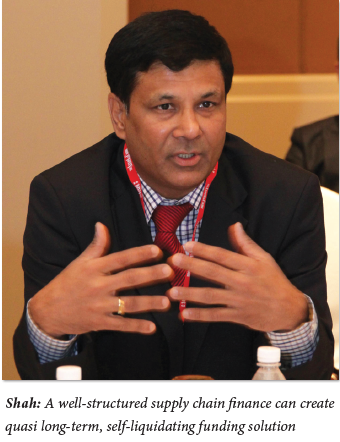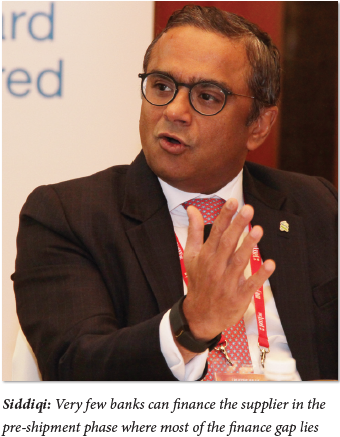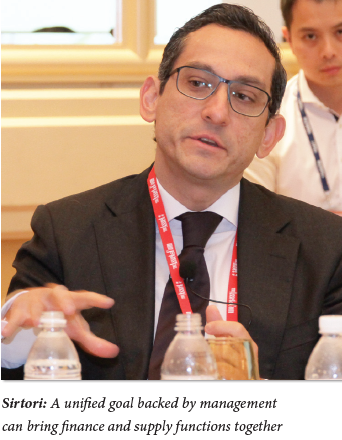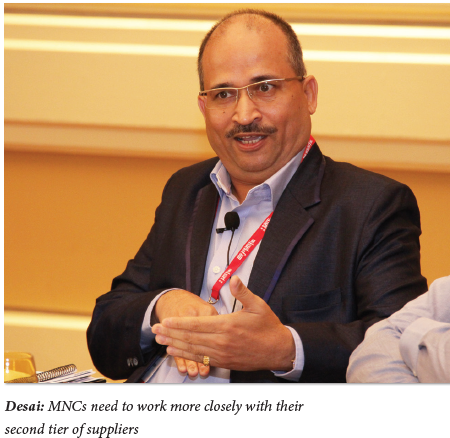Supply chain finance is a broad subject area that is difficult to pin down in just a few words. It therefore is best explained in terms of the benefits it yields. At Golden Agri-Resources, the largest listed oil palm plantation company in Indonesia, its supply chain proved to be an alternative source of funding in a tough debt capital market.
 “Supply chain finance when structured and calibrated well for risk-returns, potentially creates quasi long-term, self-liquidating funding solution for the company and the banks,” explains Gopul Shah, director, corporate treasury and structured trade finance at Golden Agri-Resources. “While the debt capital market turned challenging in recent years, we moved into bilateral trade and longer dated funding. We aligned teams, resources and technology to identify assets – its title and unencumbrances, customers’ obligations, tenors and liquidity in our supply chain. These are the ingredients the banks needed to ensure compliance. It got us about US$300 million in trade and supply chain financing, some of which was off-balance sheet that, in turn, helped our credit profile.”
“Supply chain finance when structured and calibrated well for risk-returns, potentially creates quasi long-term, self-liquidating funding solution for the company and the banks,” explains Gopul Shah, director, corporate treasury and structured trade finance at Golden Agri-Resources. “While the debt capital market turned challenging in recent years, we moved into bilateral trade and longer dated funding. We aligned teams, resources and technology to identify assets – its title and unencumbrances, customers’ obligations, tenors and liquidity in our supply chain. These are the ingredients the banks needed to ensure compliance. It got us about US$300 million in trade and supply chain financing, some of which was off-balance sheet that, in turn, helped our credit profile.” Benefits aside, setting up supply chain finance facilities is not a matter of simply approaching a company’s preferred bank. Much of the process takes place within the company, in fact. While that would seem more straightforward than seeking assistance from finance providers externally, in many cases it becomes a laborious effort that is challenging to treasury and finance functions. Making a supply chain finance programme work means internal treasury departments must step outside of their acquainted role as a supporting function – and assume an advisory role to decision makers in procurement and distribution fields.
Benefits aside, setting up supply chain finance facilities is not a matter of simply approaching a company’s preferred bank. Much of the process takes place within the company, in fact. While that would seem more straightforward than seeking assistance from finance providers externally, in many cases it becomes a laborious effort that is challenging to treasury and finance functions. Making a supply chain finance programme work means internal treasury departments must step outside of their acquainted role as a supporting function – and assume an advisory role to decision makers in procurement and distribution fields. Step 1: Bridge internal gaps
Step 1: Bridge internal gaps“We know very well that there may be a disconnect in terms of objectives between purchasing and finance,” relates Edoardo Sirtori, group vice president and treasurer for Asia at STMicroelectronics. “Purchasing may give up payment terms to secure more favourable pricing, whereas treasury wants to protect and improve DPO (Days Payables Outstanding) at all costs.”
 Weiping Li, senior financial advisor, Asia Pacific, ABB Group, agrees: “Traditionally, finance told procurement about the supplier side, saying you have this target, cut prices by x-percent. But now the discussion is much more innovative.”
Weiping Li, senior financial advisor, Asia Pacific, ABB Group, agrees: “Traditionally, finance told procurement about the supplier side, saying you have this target, cut prices by x-percent. But now the discussion is much more innovative.”This traditional divide between finance and operational units of a business has an immediate impact on what support companies can expect from external partners: “From a banker’s perspective, we do see frictions between different departments in a company,” observes Farooq Siddiqi, global head of trade, transaction banking at Standard Chartered. “That’s because of a couple of reasons: if you’re in the role of a treasurer, in the past, your role was limited to managing the balance sheet, liquidity, working capital and the risks around those. But increasingly your role touches on roles outside of this defined role – the entire supply chain. This encroaches into a space that other departments of the business had ownership of.”
Supply chain financing programmes led purely by the finance function of a company are set up for failure, warns Au Yang Sian, supply chain director at Ferrero. Sharing his first-hand experience from the perspective of the operational units, he advises how poorly designed supply chain finance programmes fail to deliver: “Setting up a target to follow is one thing, following up and through is the hardest part. You can have the most amazing strategy devised. But at the end of the day, if the foot soldier on the ground is not buying into it and continues to sell the old product mix because it’s easier, your investment is down the drain.”
Peter Schellenberger, Asia director, ship supply chain, at V.Ships Asia Group agrees: “Every company I’ve talked to, there’s a discussion about the relationship between finance and procurement. Who should create that goodwill on both sides in order to mitigate and negotiate payment terms and finance terms while not endangering the business and sales process? The bigger the company is, the more important it is to make a choice between finance and operational. My preference clearly is for those in an operational capacity.”
The key to bringing finance and supply functions together, Sirtori finds, is to create a unified goal that is backed by a strong buy-in at senior management level. “If you have a strong buy-in, it will be done. For example, let’s look at accounts receivables. Generally speaking, sales and marketing may, at times, compromise payment terms with customers to secure the billings. This impacts the DSO (Days Sales Outstanding) of the company which is an important KPI (Key Performance Indicator) of finance. Finance needs to educate other departments about the cash conversion cycle and the impact of such decisions on the organization. Companies need to cross-fertilize KPIs between departments to ensure that all are working toward common goals.”
 Step 2: Bridge external gaps
Step 2: Bridge external gapsWith the first hurdle taken and objectives within the company aligned, access to funding presents the next challenge. Most supply chain finance facilities are centred on a strong anchor client whose robust financials give banks comfort when extending credit to associated suppliers and distributors. In a classical “reverse factoring” setup, such an anchor client takes the lead and shares its purchase orders with banks so the fulfilling suppliers can receive finance against them.
What sounds like a win-win situation, sadly isn’t in every case – and often is subject to less-than-favourable stipulations for the supplier. Owing to the reality of global supply chains, companies in Asia might find some of these too harsh. “Customers with good credit quality are powerful, meaning our bargaining power as a supplier is lost. Some of our customers that have strong credit ratings have arranged reverse factoring supply chain financing from their banks at competitive rates for extended tenors up to 90 days. Because of the reverse factoring support of customer’s banking partners, suppliers can discount its receivables – but not at the cost of the customer but at its own cost of capital. That is increasingly happening. My view is that while supply chain financing helps the supplier to get their money earlier, it doesn’t necessarily help ensure funding at optimal cost every time,” relates Shah.
 “That’s when we need to take charge and build a competitive advantage around our supply chain, which means collaborating with banking partners and stakeholders, aligning cross functional teams, and creating sustainable value added supply chain financing solutions,” he adds.
“That’s when we need to take charge and build a competitive advantage around our supply chain, which means collaborating with banking partners and stakeholders, aligning cross functional teams, and creating sustainable value added supply chain financing solutions,” he adds.Golden Agri’s experience mirrors that of many Asian companies that supply to MNCs. Banking partners of their global customers may lack presence in local markets to fully understand and value the relationship between suppliers and buyers. As a result, the supplier’s historical financial statements may be the only source of information they have when deciding whether they finance receivables of local suppliers. That alone typically fails to provide enough comfort for banks to finance the receivables they hold against customers, regardless of the reputation of their customers.
“There’s a massive gap in Asia in financing, something like US$600 billion,” Siddiqi quantifies. “Very few banks can finance the supplier in the pre-shipment phase, which is where most of this finance gap lies.”
Sanjay Desai, formerly supply chain director for APAC at Huntsman agrees that access to liquidity is a major issue for Asian-domiciled businesses seeking to establish supply chain finance facilities. Rather than focusing on the balance sheet of such smaller suppliers, banks should try to quantify the value that sticky relationships between suppliers and buyers entail. That will mean exploring banking relationships beyond the first tier of global banks, though. “When you go to that second level of suppliers, local banks need to work with global banks,” he says, “and MNCs need to work more closely with their second tier of suppliers.”
 At Golden Agri, Shah and his team leveraged the fact that the company could utilize its own network of customers, suppliers, banking partners, insurers, technology providers, stakeholders and cross functional teams to unlock value in its supply chain.
At Golden Agri, Shah and his team leveraged the fact that the company could utilize its own network of customers, suppliers, banking partners, insurers, technology providers, stakeholders and cross functional teams to unlock value in its supply chain. “We’ve kept it simple and focused on creating sustainable value,” Shah explains. “We use technology as an integrator and enabler; we partner with banks, insurers, technology experts, stakeholders; and we also collaborate with functional and regional teams, and local area experts for our supply chain programme. In Indonesia, the company runs an innovative financing programme that benefits independent small and plasma plantation owners in which the local banks and/ or government provide seed capital and maintenance to small plantations until the plantations are ready for harvesting while we provide the farm technology, inputs, education; sustainability practices, and farm product offtake that is required to grow plantation. There are many ways to set up supply chain finance schemes but it all comes down to who’s the one taking the risk, rewards and is there a sustainable value for all stakeholders.”
Step 3: Monetize existing data
 Unlocking value from supply chains depends on transparency – inter-departmental within the company and with finance providers. Giving banks a clear view of unencumbered assets, title over goods, and the credit quality debtors and their obligations allows banks to assess and understand the credit risk, obligations, and operational realities of a company.
Unlocking value from supply chains depends on transparency – inter-departmental within the company and with finance providers. Giving banks a clear view of unencumbered assets, title over goods, and the credit quality debtors and their obligations allows banks to assess and understand the credit risk, obligations, and operational realities of a company. Bridging that gap requires suppliers and their customers to leverage data they would otherwise use purely for proprietary management information. “There is a massive role technology plays here,” Ashish Pujari, general manager and vice president of digital supply chain at SAP for Asia-Pacific and Japan, finds. “It’s all about information: banks don’t really know what is happening with the smaller business. So if you think about financial information such as how often a purchase order has been diluted, how often a supplier has reneged on his contract – that data is very valuable if it is accessible and channelled to the banks.”
Siddiqi agrees: “If you expose a purchase order to a bank on a real time basis, using an API (application programming interface), banks can more easily decide whether or not to provide finance.”
The key ingredient to successful supply chain finance programmes is transparency and collaboration, he adds. “What it really boils down to is whether companies are willing to share the information they hold to unlock value.” That journey begins with internal alignment and is aided by modern information technology. When combined, any company’s supply chain can become a new source of finance.





.jpg)
.jpg)


